Many pending retirees are planning to downsize in retirement. Downsizing has the benefit of releasing funds from the sale of the family home. Other potential benefits including moving to a home which is easier to maintain and also moving to a location more suitable for retirement.
There can be disadvantages to downsizing however. Downsizing often involves moving out of a familiar and desirable neighborhood and away from friends and relatives.
This post looks at financial strategies which can help retirees who would like to delay downsizing. Specifically we look at private and public sector Reverse Mortgages and also Home Reversion schemes.
As usual, we will use ourselves as case study.
Our Example
Let’s look at our case. In the 2016 in review post I updated a plan whereby we will sell the family home and move into another already owned property in a seaside town.
To recap:
- I am married with no children, and am now 54. We are Australians but living overseas at the moment. We intend to come back to Australia at some stage (present date unknown!). The plan assumes we retire in early 2017, although this may change.
- We own a house in a capital city which we intend to sell when I get to 64. Some of the house sale proceeds will go into superannuation at this time using the bring forwards rule, and remainder will go into cash.
- We own an investment property.
- We have Super and Cash assets.
- Another property in a seaside town is a possible inheritance. This plan assumes that we move into this property when we sell our main residence, and it only becomes available to us at this time. However, if this does not eventuate, we will move into our investment property. This plan assumes the former, but the latter will have similar outcomes.
- We intend to spend 10% less when we get to 70, and another 10% less when we get to 80. This reflects our likely spending requirements.
Here is the estimated spending pattern under this plan (with 2015 and 2016 shown as actuals):
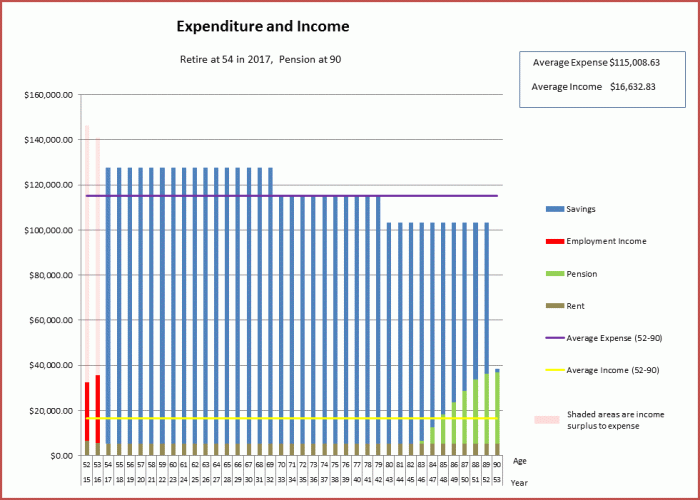
You can see the age pension becoming available at around 84. You can also see that our annual expenditure over the last 2 years has been very low (less than $40k!).
Here are the assets (in 2017 dollars), with actuals from 2014, 2015 and 2016:
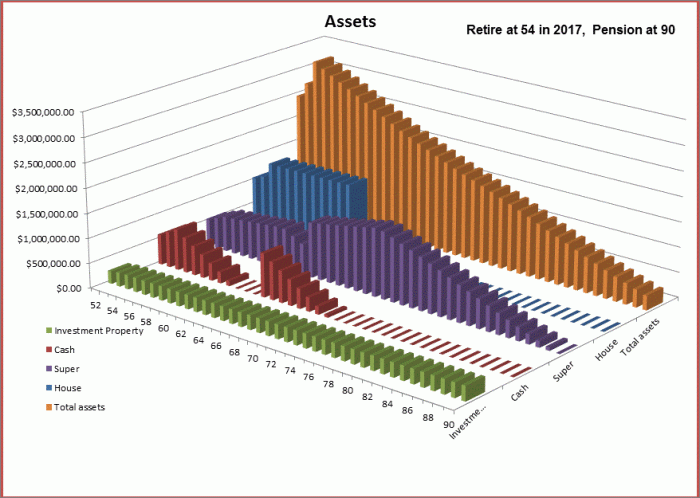
You can see the house being sold at 64, and some of the assets going into Super and some going into Cash (now that the non-concessional limit has been reduced, as per the 2016 budget, not all of the funds can go into Super).
Now, let’s assume that we want to delay the sale of the house and the move to another location (aka Downsizing). In the absence of any additional strategy, this will involve a lower level of spending prior to selling the home, and a higher level afterwards. Here is an updated plan assuming we delay the move by 10 years and that we don’t leave until 74:
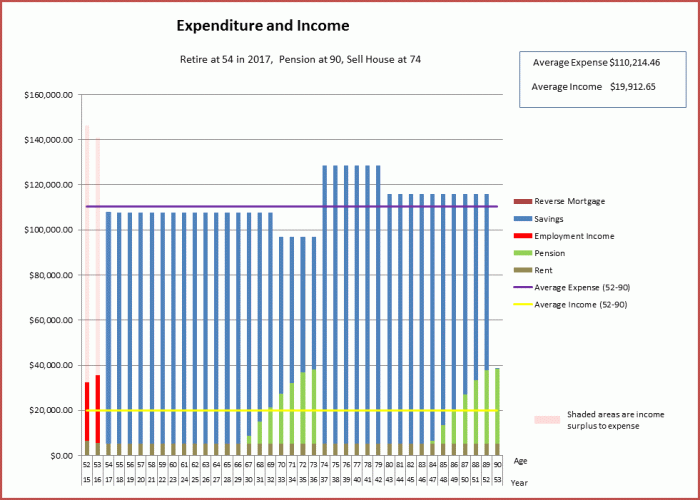
You can see that we are now eligible for the Age Pension at 67, ineligible again at 74, then eligible again at 84. Also, due to the limited amount of liquid assets prior to 74, our spending prior to 74 is lower than after 74. Ideally we would like to spend more in early retirement and less in later retirement in accordance with our chose spending pattern (10% less at 70, and another 10% less at 80) and we can no longer do this. Still, the spending levels are perfectly acceptable to me at least!
Here are the corresponding assets:
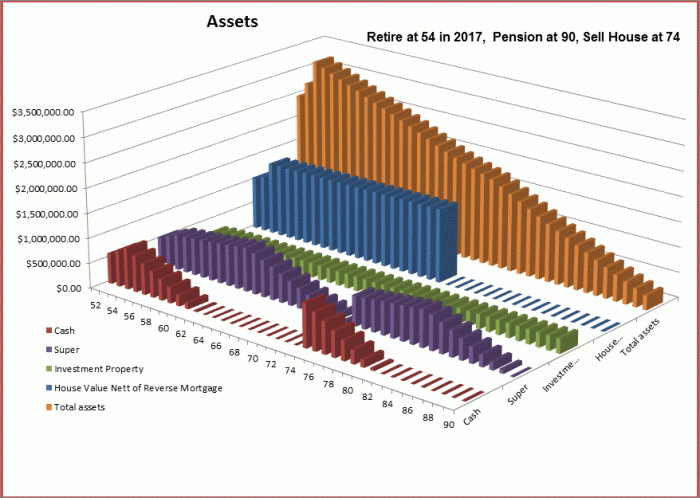
Note that I have assumed that the bring forward amount coming from the house sale can be invested in Super like assets. This should be a reasonable assumption given the SAPTO offset, but to understand the implications of this approach fully, a probabilistic approach would have to be used (refer here for an example).
Also, you can see the Super (and Cash) running out just prior to the house sale.
Here is a more extreme example whereby we plan to delay the move to 80:
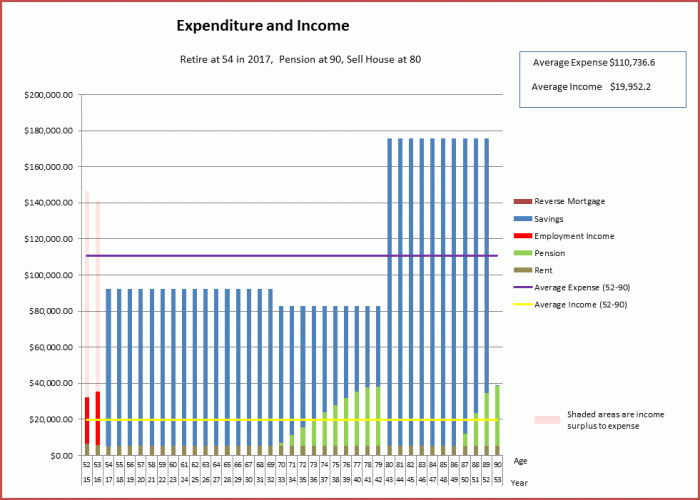
You can see that expenditure prior to 80 is quite a bit lower than the spend in other plans.
Reverse Mortgages
One strategy to help delay the house sale while at the same time minimizing the impact on funds available for spending is based on the use of Reverse Mortgages. While Reverse Mortgages have received a lot of adverse publicity, regulations on these types of products have recently improved, and there are some real advantages. Firstly and most importantly you can access the equity in your home without having to sell it. Also, most reverse mortgage products allow you to access the equity in your home as an income stream or on an as-needs basis. That is, you don’t need to access the funds as a lump sum. This means that the income source from your home should not impact your Age pension, and also you only pay loan interest on the funds you have drawn. Finally most reverse mortgage products stipulate that there can be no claims on your other assets if you end up owing more on your reverse mortgage than your home is worth, and you cannot be forced to leave your home (this is known as the “no negative equity guarantee” or NNEG).
Disadvantages or include a high interest rate (which might be expected due to the longevity risk worn by the financial institution), the fact that you can only mortgage a percentage of your home (the percentage normally increases as you age) and the need for close management of the loan as the amount owing can increase quickly due to compounding (especially as the interest rate is variable and not fixed).
SEQUAL is an industry association that promotes home equity products and the maintenance and enforcement of strong consumer protection principles for the industry and it is generally recommended that you choose a product from a participating member.
So, lets take a look at how a reverse mortgage would work. I am using as an example the Commonwealth Bank product. At the time of writing, this product allows a reverse mortgage of between 20% (if aged between 65 and 70) and 40% (if over 85) of the value of the family home (this percentage is known as the Loan to Value Ratio or LVR), with overall maximum limits of between $275K and $425K. The annual interest rate charged is 6.37%. As the level of detail in the CBA pdf is not that great, I have made certain assumptions about the product. Refer here for these.
Here is the diagram showing the spending patterns if we sell the family home at 74, and take out a reverse mortgage that commences at a time that results in our spending patterns being leveled out. I have assumed an interest rate of 6.37% throughout the mortgage.
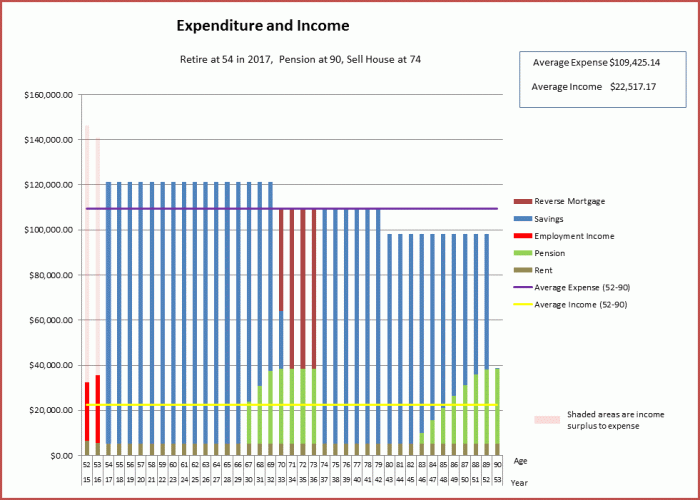
You can see that there is no increase in spending after selling the house and we maintain the 10% reduction at 70 and 80. Under the plan, the reverse mortgage value gets to about 19% of the house value. The total real (2017 dollars) of the amount borrowed is $257K. If we borrow more than this then spending prior to selling the house is too high, and if we borrow less, then it is too low.
Here is the diagram showing the assets (real values):
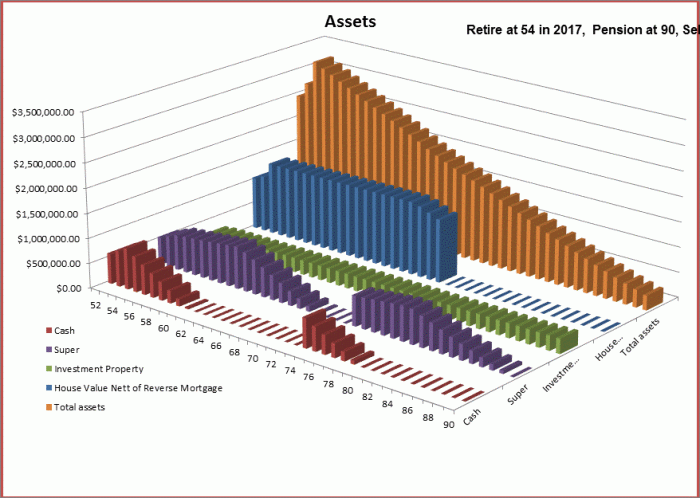
I have again assumed for the purpose of this post that I can contribute the bring forward amount of house sale proceeds to Super-like investments.
Note that the light Blue House Value is the value nett of the outstanding reverse mortgage amount. You can see the value declining near the time it is sold.
You can also see that during the period between taking out the reverse mortgage and selling the house there are no super or cash assets.
What about if we wanted to stay until 80?
Well, this is more complicated because the optimal solution involves borrowing more than the upper limits imposed by the CBA product. Here is the optimal solution, assuming there are no limits on how much we can borrow against the mortgage:
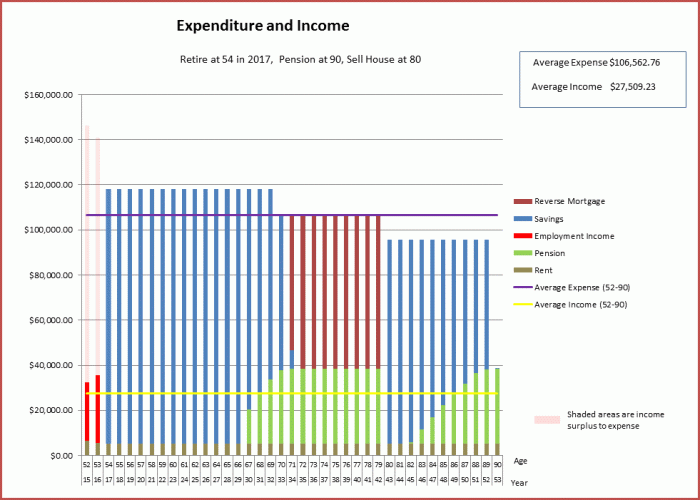
In this solution, the Reverse Mortgage gets to about 53.5% of the house value, and the real amount borrowed is approx $602K.
And here is the solution within the CBA limits:
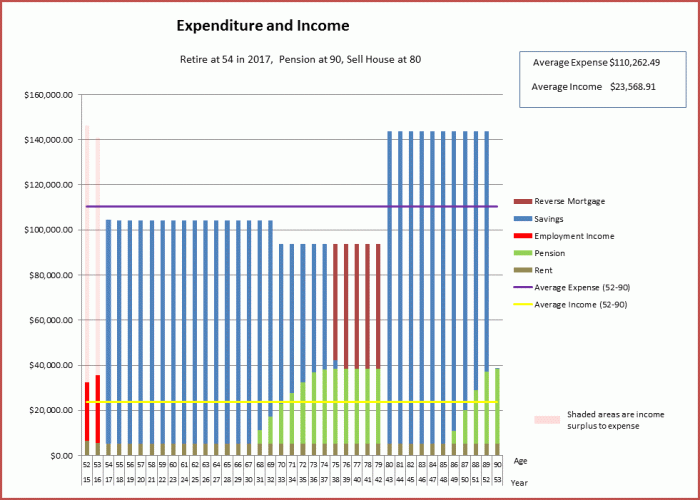
Here the real value borrowed is approximately $272K. Note that this is less than the $325K available if we started the loan at 74 because of the interest charged and also the discounting of the value of the loan by inflation.
What about another Reverse Mortgage!
It is possible to reverse mortgage our downsized second home in order to release another income stream. This would elevate spending again. If we are over 85, we could release 40% of the house value and this could feed into higher spending prior to 85.
Would we want to do this, if so when, and what are the disadvantages?
Here is the diagram for the second reverse mortgage, assuming we take it out so that drawdown funds are available up until 90, and assuming that we sell the house at 74:
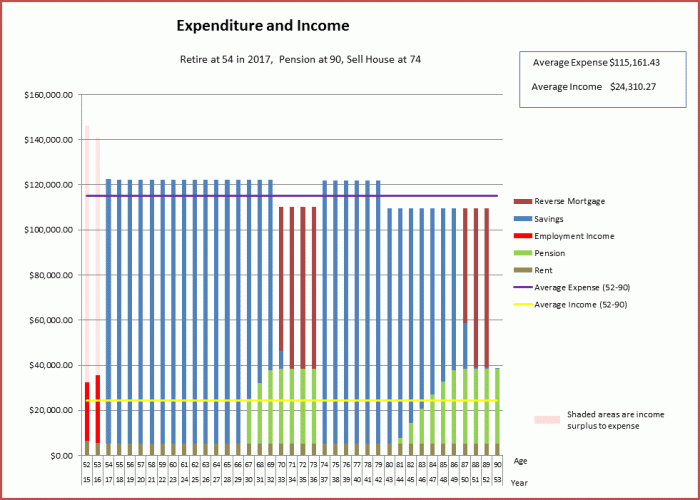
You can see that the funds released in the second reverse mortgage mean that the first reverse mortgage cannot bring forward enough funds to maintain our spending pattern. i.e. after the house sale our spending will now increase rather than remain flat.
Also, at 90, we are living on the Age Pension. As described in the mortality post, at the age of 87 it is more realistic to assume that we will live past 90, so a lower spend should be planned for. It is possible to combine this post with the mortality post to work out when it is best to take out a reverse mortgage assuming a plan based on expected longevity. I might do this later!
There is one significant advantage and one significant disadvantage to a second reverse mortgage.
The significant advantage is that the reverse mortgage never needs to be paid back because we will not be moving to another home.
The significant disadvantage is that there is potentially a small (or no) residual to be paid to any beneficiaries on death, and also, in the event that one of us needs to go into Aged Care, the lack of a property may impact on the quality of the Aged Care service. I’ll do a post on Aged Care soon in order that we can understand this better.
Using the Reverse Mortgage as described above, here is reverse mortgage value as a percentage of the house value.
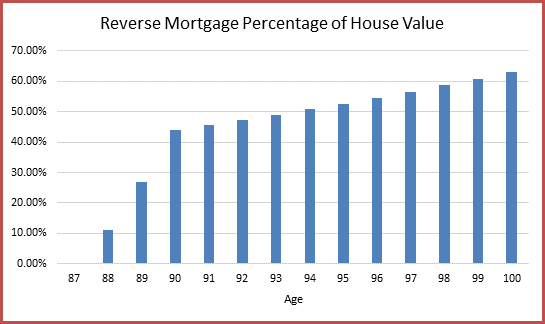
So, for example, if we were go into Aged care at 94, approximately 50% of the house value would be available to fund Aged Care.
The Pension Loans Scheme
There is an alternative to the private sector reverse mortgages. The Pensions Loans Scheme is a scheme administered by the Federal Government and has the following characteristics:
In order to be eligible:
- You (or your partner) must be over Age Pension age.
- You must have equity in Australian Real-estate.
- You must not be drawing the full age pension.
- Your ineligibility for the full age pension must not be due to both the assets test and the the incomes test.
And:
- The most you can receive is the difference between the Age Pension and your present part Age Pension (which may be zero). The amount is paid fortnightly (i.e. it cannot be taken as a lump sum) and is not taxable. So, for example, if you are not eligible for the Age Pension at all, you could receive up to the Age Pension.
- The fortnightly interest rate is 5.25% (effectively 5.4% annual rate). According to this article, the rate is fixed.
- You can continue to borrow while the value of the loan is less than Age Component Amount * (Value of Realestate Assets – Guaranteed Amount)/$10,000. The Guaranteed Amount is the amount that you wish to retain on death. If you have more than one property, you can choose which to use in the assessment for a loan.
- You can find the Age Component amount here (buried in the act documents!). Effectively you can borrow from 17% (at 55) to 67% (at 90).
- You must pay back the loan when you die or when you sell the home.
- I couldn’t find anything on the no negative equity guarantee (i.e. there can be no claims on assets outside the collateral in the event that the loan exceeds the value of the collateral). However, I believe that this would apply.
Could we use this type of loan and if not, for whom would it be attractive? Under this loan, the most income per year you can receive is the Age Pension. This assumes that you are not eligible for the any Age Pension e.g. you have at least $823K in assessable assets. Or if your assets are lower, you could receive a lower amount. The problem is, if you have these assets, you are unlikely to want to take out a loan and pay the loan interest rate! i.e. it would be more sensible to use your assets for living expenses rather than taking out a loan, but if you do this, you eventually become ineligible to take out the loan!
Seems to me that there aren’t many circumstances where this loan would be attractive. Maybe it has been deliberately made so in order not to compete with private sector products. Some people have recommended that the Age Pension eligibility criterion be removed for this product.
Home Reversion Schemes
Home Reversion Schemes are another type of scheme which permits pensioners to access equity in their homes. The idea behind this type of scheme is that you can sell a proportion of your home for a lump sum. When you sell your home, go into aged care, or die, the vendor of the product receives the agreed percentage of proceeds. The lump sum you receive is a proportion of the percentage value of the home, with the proportion getting larger the older you are.
There is only one vendor of Home Reversion Schemes in Australia, Homesafe. The characteristics of their scheme are:
- The scheme is only available to home owners in some postcodes of Sydney and Melbourne.
- You must be over 60.
- The land value of the property must be at least 60% of the value of the property, as assessed by an independent valuer.
- The maximum percentage of the home that can be sold is 65%.
- Normally the lump sum is between 35% and 65% of the percentage of the value of the home at the time the contract is signed. This will normally vary according a number of parameters, one of the most important being age.
- You retain title in the home.
- Because you receive a lump sum, this may impact on your pension.
The percentage of the house value that you receive is not published, so it is difficult to assess what kind of deal you are getting. Assuming that you don’t leave the family home, then this is equivalent to receiving a lump sum injection while sacrificing a percentage of the home for use in Aged Care or to leave to beneficiaries. Further modelling for our own situation would be dependent on availability of percentage discounts assigned to the house percentage.
Vendor Risks
It is interesting to look at the vendor risks for these types of products.
For the Reverse Mortgage product, the main risk is that the value of the outstanding loan becomes higher than the value of the property. This is more likely to occur where the property value declines or does not increase as fast as expected, the owner remains in the property for a longer time than planned, or interest rates increase to a higher level than planned. These are mitigated to some extent via the aged-dependent Loan to Value Ratio, a higher than normal interest rate, and also, where the loan is taken progressively, including the interest in the amount that can be loaned.
For the Home Reversion product, the main risk is that the value of the lump sum is not recovered (with interest) when the home is sold. This is more likely to occur in the same set of circumstances, i.e. the . property value declines or does not increase as fast as expected, the owner remains in the property for an especially long time, or interest rates increase to a higher level than planned. These risks can be mitigated by ensuring the percentage of the home given as a lump sum is appropriately discounted.
Conclusions
If you are planning on downsizing to help finance your retirement, the use of private sector Reverse mortgages can help with extending your stay in the family residence. We have shown that in our case, under certain assumptions by using Reverse Mortgages we can delay the move from our family home by about 10 years with only minimal impact on spending patterns.
The Federal Government also offers a type of Reverse Mortgage service, however there are very few instances where this services is likely to be useful.
Home Reversion Schemes may also be of help to the retiree, especially when you want to quarantine a proportion of your home for beneficiaries or help with Aged Care. It has not been possible to model how we could use a Home Reversion product because not all details are available/published.
Would I use one or more reverse mortgages?
Comparing my original spending plan with the plan using two reverse mortgages, the spending levels are roughly the same, except that in the latter, I can maintain spending levels and leave my home in 20 years rather than 10. Still, I would prefer not to manage a reverse mortgage if I didn’t have to, and having a sightly lower level of spending may be an acceptable trade-off (so the plan to leave at 74 without a reverse mortgage, which only involves a $10K reduction in spend prior to the house sale may be perfectly acceptable). The risk of interest rates going higher, and the capital in the home disappearing quickly is a real one, and something I would prefer not to deal with.
I think I will see how are our actual spending levels pan out in the first years of our retirement and if there is a real need for additional funds to see if a reverse mortgage is likely to make sense.
(*) The information on the CBA website is a bit light on details. I placed a few calls to CBA, but call center staff were not that knowledgeable either and suggested an appointment at a branch!
I have made some assumptions to help with the analysis. The general principles in this blog should remain valid, but if some of the assumptions prove incorrect, there may be need to be some minor adjustments.
I assumed:
- The Bank will continue to loan you money while the outstanding value of the loan is less than the maximum limit. If you take the loan as a lump sum, then this means you can borrow the full amount of the maximum limit. However, if you take the loan progressively, then you can only continue to draw down funds while the outstanding value of the loan is less than the maximum. As the outstanding value will increase due to interest and fees, and the real maximum value declines over time, this effectively means the real value that you can borrow will be less than the nominal maximum amount. I have based this assumption on the somewhat cryptic comment in the CBA product pdf: “Should the borrower/s choose to draw down the facility on a periodic basis, the full amount of the facility limit may not be available due to the capitalised effect of interest and fees.”
- The loan limit applicable is the limit at the time you took out the loan. That is, if for example, you have an outstanding reverse mortgage loan and you turn 85, you don’t get access to more funds reflective of the increased maximum loan at this age.
- I didn’t factor in any fees other that Interest. That is, I didn’t factor in setup fees, withdrawal fees (if any) etc. These should only have a minor impact on the overall result and introduce unwanted complications.
- I assumed maximum loan limits increase with inflation, although once the loan is taken out the limit is fixed.
Note that:
- I have worked out the amount owing on the loan based on similar techniques described in the “Mathematical Diversions” post.
- The total amount owing on the loan can be a lot more than the loan limit because there is no fixed date for paying it back. This is why the bank limits the amount you can borrow and this varies by age!